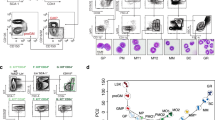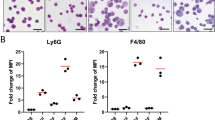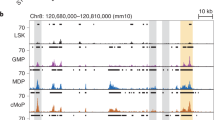Abstract
Hematopoietic transcription factors are essential for specifying cell fates; however, the function of cytokines in such developmental decisions is unresolved. We demonstrate here that haploinsufficiency for the gene encoding the transcription factor PU.1 partially suppresses the neutropenia of mice deficient in granulocyte colony-stimulating factor. This suppression was due to an increase in granulocytic progenitors and a diminution of monocytic progenitors. With PU.1+/− ES cells as well as PU.1−/− hematopoietic progenitors, we show that higher expression of PU.1 is needed for macrophage than for neutrophil development. In a PU.1−/− progenitor cell line, in which graded activity of PU.1 regulates neutrophil versus macrophage development, granulocyte colony-stimulating factor signaling supported the neutrophil cell fate by increasing expression of the neutrophil transcription factor C/EBPα in relation to expression of PU.1. Collectively, these results indicate that cytokines can promote cell fate decisions by altering the relative concentrations of lineage-determining transcriptional regulators.
This is a preview of subscription content, access via your institution
Access options
Subscribe to this journal
Receive 12 print issues and online access
$209.00 per year
only $17.42 per issue
Buy this article
- Purchase on Springer Link
- Instant access to full article PDF
Prices may be subject to local taxes which are calculated during checkout






Similar content being viewed by others
Change history
15 September 2003
appended AOP PDF with erratum (will be corrected for print issue) and placed footnote in SGML where references to Fig. 4a occur
References
Metcalf, D. Lineage commitment and maturation in hematopoietic cells: the case for extrinsic regulation. Blood 92, 345–347 (1998).
Enver, T., Heyworth, C.M. & Dexter, T.M. Do stem cells play dice? Blood 92, 348–351 (1998).
Cantor, A.B. & Orkin, S.H. Hematopoietic development: a balancing act. Curr. Opin. Genet. Dev. 11, 513–519 (2001).
Wiktor-Jedrzejczak, W. et al. Total absence of colony-stimulating factor 1 in the macrophage-deficient osteopetrotic (op/op) mouse. Proc. Natl. Acad. Sci. USA 87, 4828–4832 (1990).
Yoshida, H. et al. The murine mutation osteopetrosis is in the coding region of the macrophage colony stimulating factor gene. Nature 345, 442–444 (1990).
Stanley, E. et al. Granulocyte/macrophage colony-stimulating factor-deficient mice show no major perturbation of hematopoiesis but develop a characteristic pulmonary pathology. Proc. Natl. Acad. Sci. USA 91, 5592–5596 (1994).
Lieschke, G.J. et al. Mice lacking granulocyte colony-stimulating factor have chronic neutropenia, granulocyte and macrophage progenitor cell deficiency, and impaired neutrophil mobilization. Blood 84, 1737–1746 (1994).
Lieschke, G.J. CSF-deficient mice—what have they taught us? Ciba Found. Symp. 204, 60–74 (1997).
Fairbairn, L.J., Cowling, G.J., Reipert, B.M. & Dexter, T.M. Suppression of apoptosis allows differentiation and development of a multipotent hemopoietic cell line in the absence of added growth factors. Cell 74, 823–832 (1993).
Shivdasani, R.A. & Orkin, S.H. The transcriptional control of hematopoiesis. Blood 87, 1025–4039 (1996).
Orkin, S.H. Diversification of haematopoietic stem cells to specific lineages. Nat. Rev. Genet. 1, 57–64 (2000).
Graves, B.J. & Petersen, J.M. Specificity within the ets family of transcription factors. Adv. Cancer Res. 75, 1–55 (1998).
Dahl, R., Hackenmiller, R.D. & Simon, M.C. Ets transcription factor mutations and hematopoiesis. in Hematopoiesis: A developmental approach (ed. Zon, L.I.) 391–401 (Oxford University Press, New York, 2001).
Scott, E.W., Simon, M.C., Anastasi, J. & Singh, H. Requirement of transcription factor PU.1 in the development of multiple hematopoietic lineages. Science 265, 1573–1577 (1994).
McKercher, S.R. et al. Targeted disruption of the PU.1 gene results in multiple hematopoietic abnormalities. EMBO J. 15, 5647–5658 (1996).
Nerlov, C. & Graf, T. PU.1 induces myeloid lineage commitment in multipotent hematopoietic progenitors. Genes Dev. 12, 2403–2412 (1998).
McIvor, Z. et al. Transient expression of PU.1 commits multipotent progenitors to a myeloid fate whereas continued expression favors macrophage over granulocyte differentiation. Exp. Hematol. 31, 39–47 (2003).
DeKoter, R.P. & Singh, H. Regulation of B lymphocyte and macrophage development by graded expression of PU.1. Science 288, 1439–1441. (2000).
Pevny, L. et al. Erythroid differentiation in chimaeric mice blocked by a targeted mutation in the gene for transcription factor GATA-1. Nature 349, 257–260 (1991).
Zhang, P. et al. PU.1 inhibits GATA-1 function and erythroid differentiation by blocking GATA-1 DNA binding. Blood 96, 2641–2648 (2000).
Zhang, P. et al. Negative cross-talk between hematopoietic regulators: GATA proteins repress PU.1. Proc. Natl. Acad. Sci. USA 96, 8705–8710 (1999).
Kondo, M. et al. Cell-fate conversion of lymphoid-committed progenitors by instructive actions of cytokines. Nature 407, 383–386 (2000).
King, A.G., Kondo, M., Scherer, D.C. & Weissman, I.L. Lineage infidelity in myeloid cells with TCR gene rearrangement: a latent developmental potential of proT cells revealed by ectopic cytokine receptor signaling. Proc. Natl. Acad. Sci. USA 99, 4508–4513 (2002).
Scott, E.W. et al. PU.1 functions in a cell-autonomous manner to control the differentiation of multipotential lymphoid-myeloid progenitors. Immunity 6, 437–447 (1997).
Olson, M.C. et al. PU.1 is not essential for early myeloid gene expression but is required for terminal myeloid differentiation. Immunity 3, 703–714 (1995).
Garrett-Sinha, L.A., Dahl, R., Rao, S., Barton, K.P. & Simon, M.C. PU.1 exhibits partial functional redundancy with Spi-B, but not with Ets-1 and Elf-1. Blood 97, 2908–2912 (2001).
Lagasse, E. & Weissman, I.L. Flow cytometric identification of murine neutrophils and monocytes. J. Immunol. Meth. 197, 139–150 (1996).
Dahl, R., Ramirez-Bergeron, D.L., Rao, S. & Simon, M.C. Spi-B can functionally replace PU.1 in myeloid but not lymphoid development. EMBO J. 21, 2220–2230 (2002).
Schaller, E. et al. Inactivation of the F4/80 glycoprotein in the mouse germ line. Mol. Cell. Biol. 22, 8035–8043 (2002).
Walsh, J.C. et al. Cooperative and antagonistic interplay between PU.1 and GATA-2 in the specification of myeloid cell fates. Immunity 17, 665–676 (2002).
Pahl, H.L. et al. The proto-oncogene PU.1 regulates expression of the myeloid- specific CD11b promoter. J. Biol. Chem. 268, 5014–5020 (1993).
Zhang, D.E. et al. Absence of granulocyte colony-stimulating factor signaling and neutrophil development in CCAAT enhancer binding protein α-deficient mice. Proc. Natl. Acad. Sci. USA 94, 569–574. (1997).
Reddy, V.A. et al. Granulocyte inducer C/EBPα inactivates the myeloid master regulator PU.1: possible role in lineage commitment decisions. Blood 100, 483–490 (2002).
Kim, J. & Feldman, R.A. Activated Fes protein tyrosine kinase induces terminal macrophage differentiation of myeloid progenitors (U937 cells) and activation of the transcription factor PU.1. Mol. Cell. Biol. 22, 1903–1918 (2002).
Radomska, H.S. et al. CCAAT/enhancer binding protein α is a regulatory switch sufficient for induction of granulocytic development from bipotential myeloid progenitors. Mol. Cell. Biol. 18, 4301–4314 (1998).
Friedman, A.D. Transcriptional regulation of granulocyte and monocyte development. Oncogene 21, 3377–3390 (2002).
McNagny, K. & Graf, T. Making eosinophils through subtle shifts in transcription factor expression. J. Exp. Med. 195, F43–47 (2002).
Lin, J.X. et al. The role of shared receptor motifs and common STAT proteins in the generation of cytokine pleiotropy and redundancy by IL-2, IL-4, IL-7, IL-13, and IL-15. Immunity 2, 331–339 (1995).
Panopoulos, A.D., Bartos, D., Zhang, L. & Watowich, S.S. Control of myeloid-specific integrin αMβ2 (CD11b/CD18) expression by cytokines is regulated by STAT3-dependent activation of PU.1. J. Biol. Chem. 277, 19001–19007 (2002).
Shibata, Y. et al. GM-CSF regulates alveolar macrophage differentiation and innate immunity in the lung through PU.1. Immunity 15, 557–567 (2001).
DeKoter, R.P., Walsh, J.C. & Singh, H. PU.1 regulates both cytokine-dependent proliferation and differentiation of granulocyte/macrophage progenitors. EMBO J. 17, 4456–4468 (1998).
Acknowledgements
We acknowledge S. Reiner and K.C. Dahl for critically reading the manuscript. We thank the following for providing reagents: W. Pear, M. Lazar, R. Feldman and N. Berliner. This work was supported by the Abramson Family Cancer Research Institute (R.D. and M.C.S.) and the Howard Hughes Medical Institute (R.D., D.L., P.L., S.R.I., H.S. and M.C.S.), and National Institutes of Health grants 5RO1HL052094 (M.C.S.), 5T32GM07151 (J.C.W.) and 5T32HL07237 (J.C.W.) M.C.S. and H.S. are investigators of the Howard Hughes Medical Institute.
*Note: In the version of this article originally published online, the label for Figure 4a was incorrect. It should read PU.1-/-. This error has been corrected for the HTML and print versions of the article.
Author information
Authors and Affiliations
Corresponding authors
Ethics declarations
Competing interests
The authors declare no competing financial interests.
Supplementary information
Rights and permissions
About this article
Cite this article
Dahl, R., Walsh, J., Lancki, D. et al. Regulation of macrophage and neutrophil cell fates by the PU.1:C/EBPα ratio and granulocyte colony-stimulating factor. Nat Immunol 4, 1029–1036 (2003). https://doi.org/10.1038/ni973
Received:
Accepted:
Published:
Issue Date:
DOI: https://doi.org/10.1038/ni973
This article is cited by
-
Systemic Listeria monocytogenes infection in aged mice induces long-term neuroinflammation: the role of miR-155
Immunity & Ageing (2022)
-
Blood and immune development in human fetal bone marrow and Down syndrome
Nature (2021)
-
A transcription factor PU.1 is critical for Ccl22 gene expression in dendritic cells and macrophages
Scientific Reports (2019)
-
An Effective Model of the Retinoic Acid Induced HL-60 Differentiation Program
Scientific Reports (2017)
-
C/EBPα deregulation as a paradigm for leukemogenesis
Leukemia (2017)



